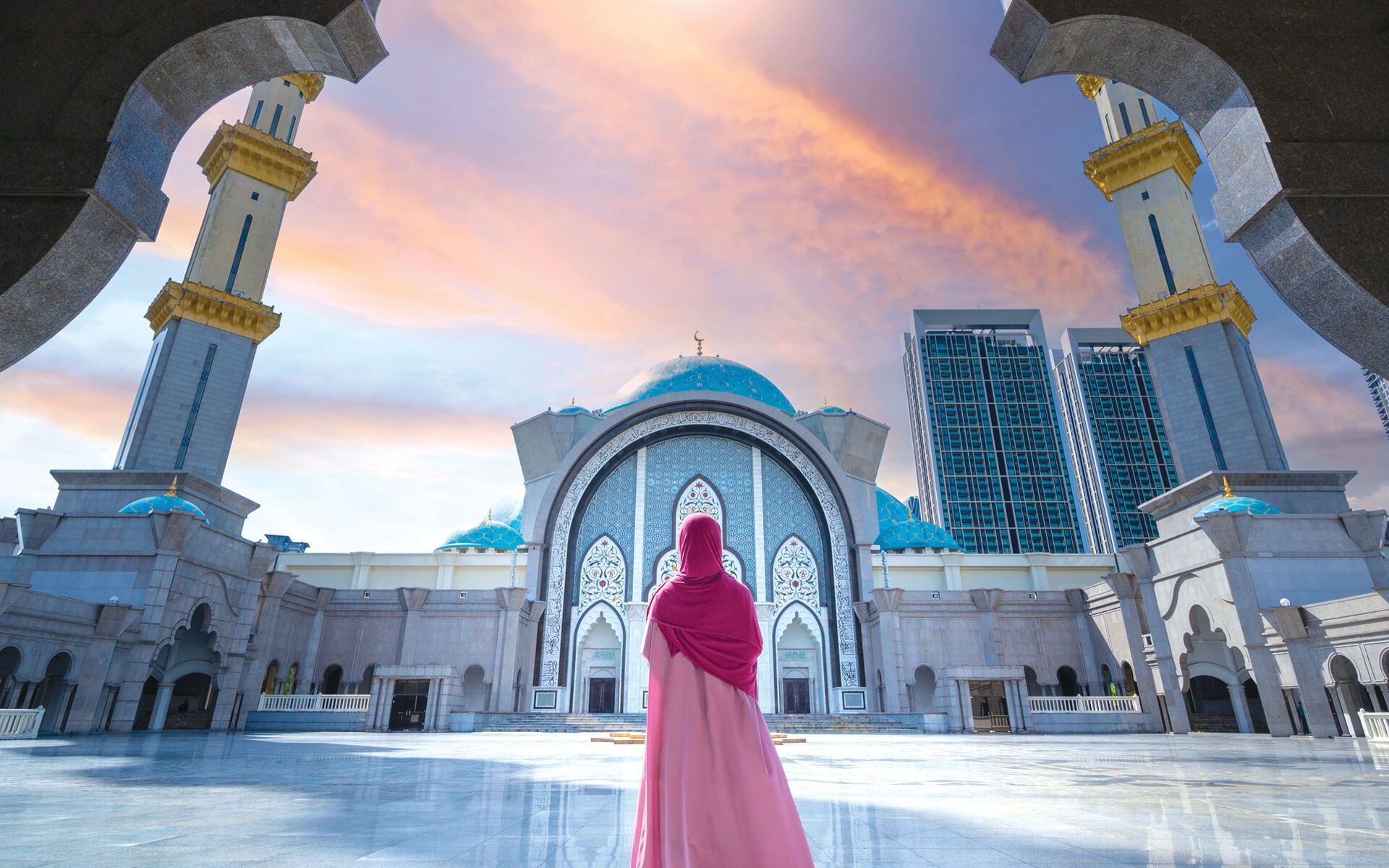The Enchanting World of the Houses of Worship

In This Article
-
Places of worship stand as an atlas of faith and religion for those open to the Divine. The sanctuaries continuously echo with the most enchanting poetry and melodies of spiritual ecstasy, hope, and security.
-
Mosques have profound significance as integral components of Islamic culture with their multifaceted roles beyond mere places of worship, embodying spiritual, social, and educational dimensions.
-
With their nurturing ambiance and role as spiritual sanctuaries, there is an intricate connection between mosques and the community.
Houses of worship play a pivotal role in showcasing a significant aspect of Islamic culture. When viewed as comprehensive complexes with their facilities, masjids or mosques embody a distinctive heritage of Muslim civilization. These sacred spaces are intricately linked to the essence and significance of our spirituality. The comforting life within their embrace seamlessly integrates into the surrounding community, establishing a horizon that shapes the identity of residents in a city or village. These places become akin to a nurturing mother, radiating the warmth of home. Throughout the day, believers eagerly converge on the mosque, experiencing the anticipation and enthusiasm of reuniting with the Beloved.
Irrespective of our location, these sacred spaces instill spirituality and profound meaning into our hearts, much like the essential elements of oxygen and water. Every sound and word resonating within this environment captivates us, resembling enchanting and magical poetry. In Anatolia, my homeland, a deep soulful connection exists among mosques, their surroundings, and other mystical bonds – a connection that makes Anatolia like a unified place of worship (although there was a time when this glory was temporarily dimmed by a passing eclipse) [*]. Anatolia – this expansive worship complex is sustained by a distinctive community, comprising caretakers, an administrative council, and dedicated worshippers, all united in fulfilling the mosque's purpose. Collectively seeking God’s pleasure and sharing a common goal, they altogether bear such a sound stance with such compelling conviction that nearly everyone encountering this complex for the first time perceives it as miraculous – they are mesmerized by the otherworldly foundations upon which it stands and the ethereal art emanating from it.
The majority of these places of worship extend beyond the mosque itself, forming integrated structures with adjoining annexes such as schools, soup kitchens, and quest quarters. Some even include spaces for spiritual retreat, clinics, public baths, and caravanserais. Viewing these structures in their entirety evokes a sense of witnessing a perfectly formed human being. The various implications and signs emanating from them resonate deeply with individuals, filling them with a sense of awe while immersed in an exceptionally warm and welcoming atmosphere. Indeed, these places of worship stand as an atlas of faith and religion for those open to the Divine. The sanctuaries continuously echo with the most enchanting poetry and melodies of spiritual ecstasy, hope, and security. In this land of mosques, as the sun moves from east to west signaling the time of prayer, believers observe the skies filling with light at every hour of the day. Words of glorification ascend from the earth, and the earth mirrors heavenly colors and patterns, transforming the earth into a semblance of the heavens. Indeed, each moment proclaims the truth encapsulated in the following verses:
“The sky is inundated with light from thousands of minarets,
When the spirit of Muhammad soars
“God is great” witness all the spirits
When from the Throne the voice of Muhammad echoes.”
(Yahya Kemal)
Subsequently, waves of worship, intercession, and a compassionate breeze sweep into every heart. Aligned with their intended purpose, the design of these mosques, from their domes to minarets, and the enthusiasm, poise, and devotion of their worshippers and councils, constantly direct attention towards the heavens and a life beyond, appearing as a manifestation thereof. A radiance gleams through their windows, and the illuminated messages adorning their minarets twinkle like the stars in the sky – as captivating as the charms that permeate the gateways to a world beyond, enveloping us with whispers from realms surpassing our imagination. In their presence, it perpetually feels as though we are beholding the beauty of the eternal world, the light of the heart and spiritual horizon, and the color and beauty of our glorious past. Amidst the sounds and voices resonating from these places of worship, we encounter enchanting words beckoning us towards God, receiving unwavering signals regarding our near and distant future.
Within their broad scope of functions, these mosques serve as centers of learning, hearths of abstinence, and, in terms of connecting with the beyond in our inner worlds, they are virtually like surveillance bases, platforms that elevate individuals to God by virtue of the various forms of servitude. Those who frequent these platforms several times a day and draw unique spiritual inspirations from them are unlikely to feel stranded in their journey. Conversely, those who oppose these platforms are unlikely to find their way to God.
These mosques are the refuge where believers rush several times a day to breathe the atmosphere of the world beyond. They are the places from which the spirit of Muhammad blossoms morning and night, resonating with the sounds of ritual ablutions blending harmoniously with cascading fountain waters, ascending to God. Within their precincts, the fluttering of pigeon wings and the heartfelt utterances of believers fashion a choir-like ambiance in the courtyard. Here, the souls in sacred graves and tombs undergo daily purification through the recitation of the Qur’an and words of praise. Mosques are where tears compete with ablution waters, and foreheads eagerly yearn to prostrate, offering solace to weary souls. As long as these places of worship continue to fulfill their purpose and serve as such, this civilization of mosques will endure, perpetually drawing people like a place of pilgrimage.
It is as though these mosques, regarded as the seal of our culture, were not constructed following any specific geometric pattern or plan, but rather established upon a vast, heavenly dimension intricately linked to the principles, symbols and signs of faith that provide us with the opportunity to observe the world beyond. Upon closer examination of these constructions, we can discern figures that reflect the boundless abundance of our souls, our dreams of eternity, our understanding of faith within the realms of sincerity and devotion, the diverse spectrum of observances, the signs mirroring the joys and fates of our life’s journey, beams of light emanating from our expectations and hopes, the hues springing from our victories, the most dramatic motifs from our heroism epics, and the yearning for reunion with the Beloved from our own romanticism. In the features of some of these mosques one can witness the light of great intentions that lie behind them. In others, one can witness the colors of a heartfelt offering they were built for, the reverence to the parents they were dedicated to, the compassion in the memory of a lost child, the traces of a solace for a grief, the faded colors of the atonement for sins, and the gleams of gratitude for the various honors attained.
Certainly, as we delve into contemplating and paying attention to the culture embodied by these places of worship, we inevitably encounter various aspects as mentioned above. In the process, we discover a reflection of ourselves within these houses of God. Wherever we come across these sacred abodes, they evoke a profound sense of spiritual exhilaration, serving as a reflection of the essence and spirituality behind the images in our minds.
Within the spectrum of these places of worship, there exist magnificent ones, akin to majestic mountains symbolizing sovereignty, and midsize ones that signify the common folk. A third type of mosque may appear with a delicate and elegant appearance, seemingly constructed for children or the youth. However, from the grandest to the most modest, each mosque stands as if constituting a piece of a larger whole, connected by the same spirit, meaning, and inner content. These mosques, in their distinct languages, consistently communicate the same truths and reminders. We listen to their utterances like music, comprehending their language to the extent possible. Throughout the mysterious span of time spent in mosques, we embrace the meaning of their words, sensing that they raise their hands with us in supplication to the One who cares for all our needs.
Some of these places of worship are situated atop high hills, commanding visibility to all, appearing so magnificent and outstanding that we envision them as intersections between this world and the next. With such a striking presence, they ignite our passions, evoke yearnings, and instill a sense of homesickness, beckoning us to the realms beyond. Through their appearance, they whisper many things from their inner mysteries, inviting us to contemplate the transcendental. Many of these places of worship appear to envelop us with their elegant, delicate, gentle, and warm atmosphere, extending a welcoming embrace. They beckon our souls with melodies of eternal compassion, even in the absence of the call to prayer (adhan).
Some mosques find their home on a plain. They resemble a dervish with his hand on his heart saying, “as God wills,” and extending a welcoming gesture to visitors. Others mirror the demeanor of a dedicated professor devoted to knowledge and research, emanating a dignified influence on all. There are also those resembling the common folk we encounter almost everywhere, embodying a nature of friendliness.
Each of these sacred places stands like the shade of the Lote Tree of the Furthest Boundary (Sidrat al-Muntaha). Regardless of their resemblance, nearly all of them possess a distinctive style and grace, as if they emerged from the core essence, the spirit, and body of our nation. They harmonize with our spiritual roots and inner meanings. Each visit feels as though we have encountered a part of the heritage of our own emotions, perceptions, or subconscious.
Depending on their location, these mosques exhibit certain mysterious characteristics in addition to their spiritually inspiring appearance. They boast delicate, beautiful, graceful, and esthetic aspects that, if not for the presence of clumsily constructed concrete apartment buildings around them, would reveal an enchanting harmony with their surroundings. Indeed, as a worshipper approaches these mystical places, there’s a sensation of ascending to a peak, the truth of which they anticipate experiencing within the mosque. Particularly in the places where structural plans of old are preserved, as people walk past neighboring houses on their way to the mosque through the streets, it feels like a journey towards the house of God, a reunion with their Creator. With each step, they feel a new sense of relief and exhilaration. In their perception, each of these paths, whether short or long, that leads them to this sacred abode becomes a place of worship – holding a value far beyond their physical nature.
Through the eyes of such a person, everything along the way feels like a familiar face: the neighborhoods they pass through, the streets they walk on, the buildings they encounter, and the walls under whose shade they find refuge. It is almost as if they accept and return their greetings, feel their warmth, and convey friendliness. The windows they pass by welcome them with radiant smiles. Every stop and every distance they cover seem to accompany them like a conscious being, or a trusted travel companion. Eventually, each of these companions bids farewell, entrusting them to the next, as they continue their journey.
Upon reaching the entrance or the courtyard surrounding the mosque, worshippers are welcomed by the harmonious sounds of water, the fluttering of bird wings, and the rustling of trees, creating a melodic symphony. They absorb every element, every sound, every melody, every aspect of excellence as if they were beside the rivers of Paradise. With hidden and deeply personal emotions, they move between themselves and the world beyond, feeling like they are walking towards their own private chambers. As they shift their attention towards prayer, they turn with full focus and utter only the name of God. At this moment, the sounds of water, bird wings, and rustling trees fade away, replaced by the meanings flowing into their hearts as they proclaim His greatness. With each call of God's unification, they inhale and exhale, exhilarated by the remembrance of God, attempting to perceive Him in every sound and every word.
Indeed, when “pilgrims of prayer” reach this point, they find themselves completely enchanted by heavenly pleasures far beyond imagination. As they immerse themselves into the ebb and flow of fervor and deliberation, this final station of the physical world—which, as it were, can be considered “the privy chamber of the Holy”—and its animate-inanimate accessories echo with the melodies of the world beyond, for those attuned to perceive. It prepares people for a life of peace and prosperity. Indeed, for the heedful souls, everything speaks of God in its own unique language, conveying certain concealed whispers of Him in every form and conduct.
If these pilgrims of prayer are purified from worldly emotions through the calls to prayer (adhan and iqamah) and their committed intentions, and if they have been successful in submitting themselves by saying “God is great,” then they enter a heavenly state, envisioning themselves standing among the prophets, saints, and companions of God before their Lord, fully prepared for worship. From the moment they follow the imam in congregational prayers, they experience eternal delight as if they are following the greatest imam of all, the Prophet Muhammad, peace and blessings be upon him. In accordance with the purity of their hearts, they become completely unmindful of their physical desires, and are virtually overpowered by the pleasure of God. They fill their hearts with the love of God, or at least try their utmost to do so, adorned with the colors of the spiritual state they are in. A divine purification of this kind will constantly take them around the magnificent slopes of tranquility throughout the prayer, reaching pleasures of fear and affection impossible to attain in this world.
Due to the inner profoundness of these places of worship, those whose hearts are open to the Divine perceive them as a launching pad to the Truth. If they were to visit these abodes of worship not just five times, but many times every day, they always go with a new sense of hope, revived determination, and visions of purity. Each visit becomes another reunion with the Creator. Their sorrow upon leaving the mosque is immediately extinguished by the anticipation of their next visit. With eyes fixed on the mosque and ears attentive to the call from the minarets, they live in commitment to that call within the horizon of these sanctuaries.
* Turkey was ruled by a single-party regime with an iron fist from 1920s up to 1950s. Having adopted an extreme form of secularism, the regime aimed to transform the Turkish society with uncompromising secular values. In that direction they implemented a very oppressive program and outlawed many religious communities, banned certain forms of religious attire, and did not even allow the call to prayer (adhan) to be performed in its original form in Arabic.









